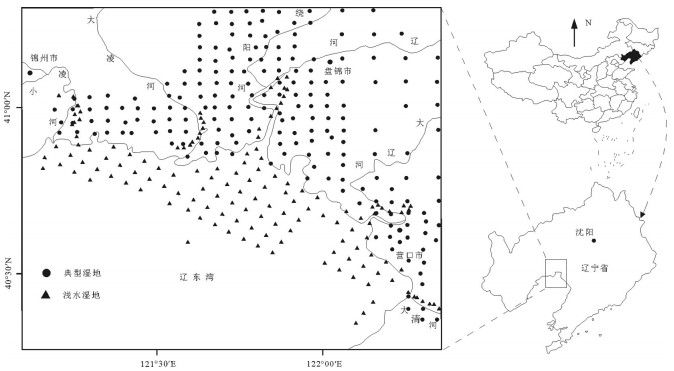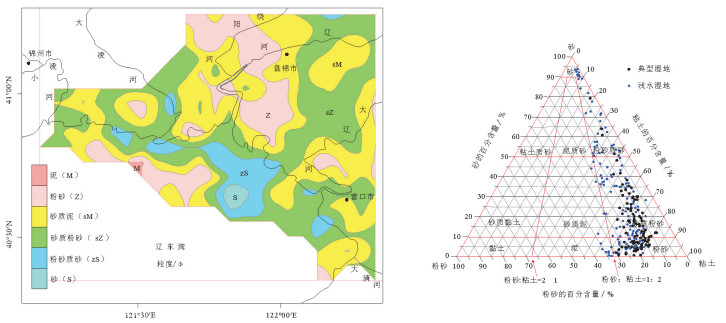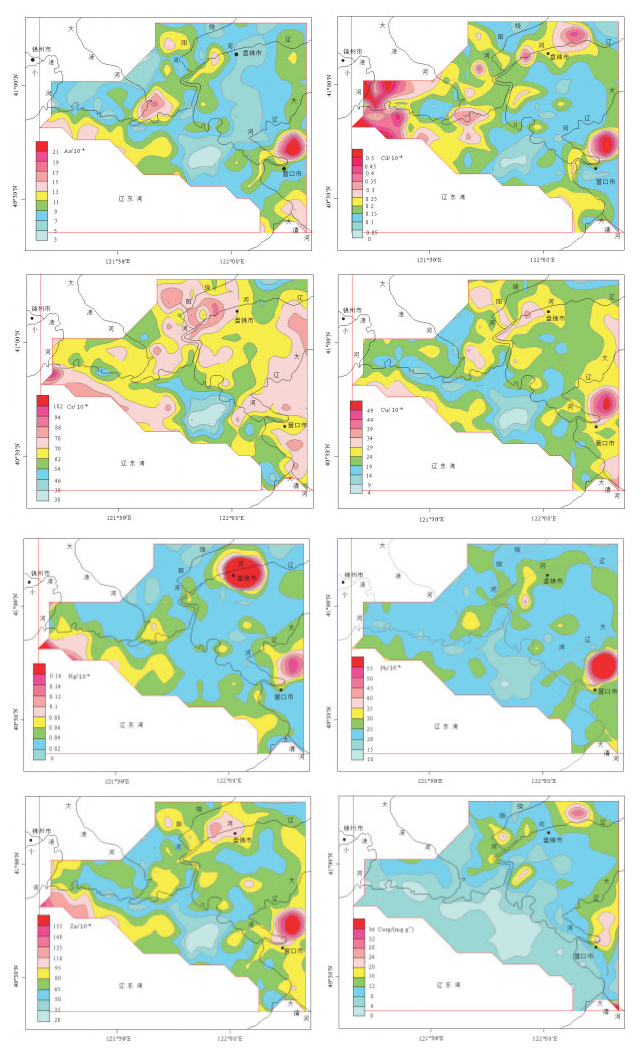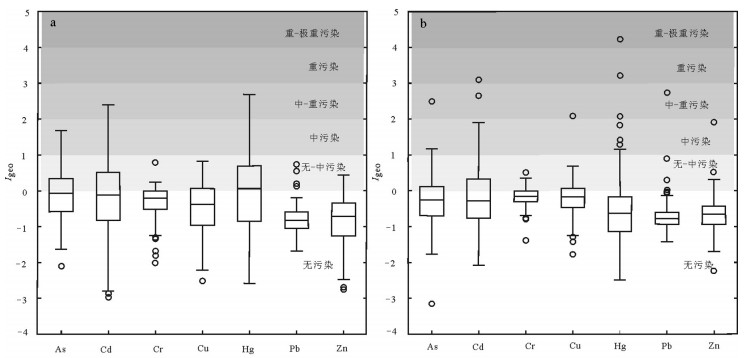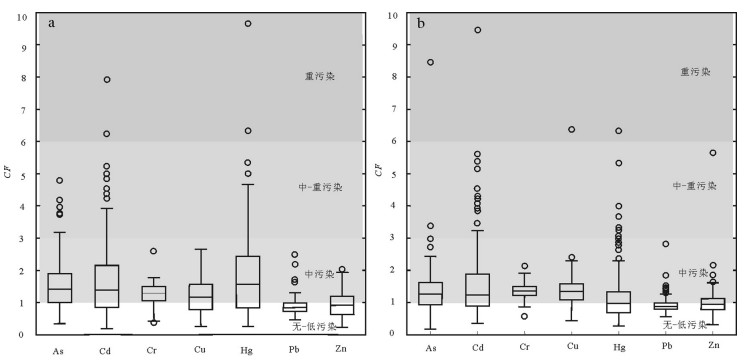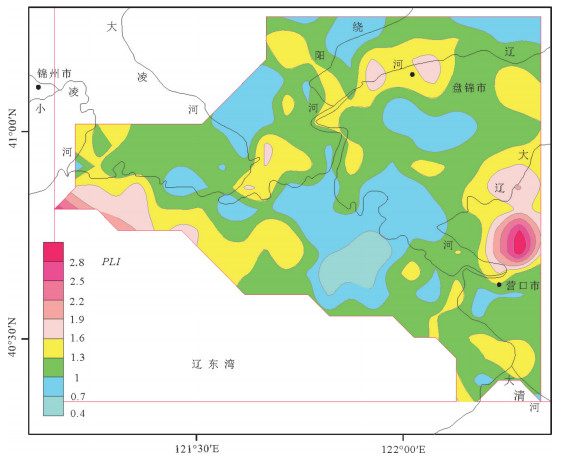Heavy metal distribution in the wetland sediments of the Liaohe delta: Implications for filter function of wetlands
-
摘要:
为了研究辽河三角洲湿地表层沉积物中重金属元素含量及其与有机碳的相关性,探讨湿地对重金属元素的移除作用,对233个辽河三角洲上三角洲平原湿地(典型湿地)表层沉积物样品和150个相邻浅海湿地(浅水湿地)表层沉积物样品,进行了化学分析测试及数理统计分析,并运用多种评价方法进行重金属污染风险评价。结果显示:①重金属元素浓度量级大小均遵循Cr(Zn) > Pb > Cu > As > Cd > Hg的分布规律;②除As和Hg外,其他金属元素浓度均表现为浅水湿地显著低于典型湿地,暗示湿地生态系统对污染物的移除作用;③除Pb和Zn外,其他重金属元素对环境均造成了中度污染;④重金属元素分布受有机碳和粒径大小的显著影响,浓度存在显著的相关性,浅水湿地表层沉积物重金属元素浓度及其与有机碳之间的相关性更显著,揭示有机碳对重金属的螯合作用;⑤在有湿地分布的浅海湿地区,重金属元素浓度均表现为浅水湿地显著低于典型湿地,暗示湿地生态系统对污染物的移除作用,相反,在大规模湿地被改造成农田的锦州海岸带地区,造成了近海浅水湿地的严重污染。该研究揭示了滨海湿地对重金属元素的过滤作用及在缓解环境污染过程中的重要意义。
Abstract:Heavy metals (As, Cd, Cr, Cu, Hg, Pb, Zn), organic carbon (Corg) and grain size of 223 surface sediment samples in the Liaohe upper delta plain wetland (UDPW) and 150 surface sediment samples in neighboring shallow sea wetland (SSW) were analyzed to evaluate the spatial distribution and assess the risk of metal pollution. Concentrations of heavy metals in sediments from both UDPW and SSW are in the decreasing order of Cr (Zn) > Pb > Cu > As > Cd > Hg. The results of two-sample-t-tests indicate significant higher heavy metal concentrations in UDPW compared with SSW except As and Hg, implying the accumulation or biouptake of particulate metal within the wetland ecosystem and reducing metal input to marine coastal systems. Multiple assessment approaches, namely, the metal enrichment factor (EF), geoaccumulation index (Igeo), contamination factor (CF) and pollution load index (PLI) were jointly used to explore the risks of the anthropogenic contaminations. The results indicate unpolluted nature for Pb and Zn, moderate degree of contamination for the remaining metals both in UDPW and SSW. Furthermore, the distribution of heavy metals is substantially influenced by grain size and the concentration of Corg, and there is significant correlation between the concentrations of heavy metal, especially for the concentration of Corg and heavy mentals in surface sediment samples of shallow sea wetland (r=0.439, p < 0.01), revealing the metal chelation acted by organic matter.
-
Keywords:
- heavy mental /
- surface sediment /
- pollution assessment /
- wetlands /
- filtration function of wetlands
-
“玻璃地球”(Glass Earth)计划最初由澳大利亚学者提出,指应用地质、地球物理勘探和三维可视化技术,使大陆表层1000m以浅“像玻璃一样透明”,并通过计算机网络技术为地质工作者及社会公众提供地学信息分析及决策支持服务[1]。它主要用于描述地壳浅层地质结构、成分及其空间拓扑关系,釆集、管理和处理基础地质调查、矿产地质勘查、矿产资源开釆、地下水管理、矿权管理与生产安全监控、工程地质、灾害地质勘查等信息。加拿大和法国相继提出了类似的计划,把目标提高到地下3000m以浅[2-3]。随后,其他欧美国家纷纷响应并制定了相应的规划,开展了关键技术研究[1, 4],其中深部勘探技术和三维地质建模技术得到长足发展[5-7]。在资源与环境的双重压力下,让地球深部“透明化”已成为越来越多国家关注的热点。
中国地质找矿和地质灾害监测预警所需的深部地质信息还比较匮乏,迫切需要基础地质工作者转变工作模式。近年来,随着计算机三维技术的迅速发展,三维地质填图和建模作为描绘地质信息的技术手段也逐渐成熟[8]。因此,中国基础地质调查“从传统走向现代、从单一走向综合、从二维走向三维”的理念呼之欲出。2012年,中国地质调查局正式启动三维地质调查试点项目,设立了一个计划项目,在地壳结构、含油气盆地、成矿带、矿集区、经济区、技术方法等领域设置了14个工作项目。《相山火山盆地三维地质调查》是其中的一个工作项目,重点探索矿集区1:5万甚至更大比例尺的三维地质调查方法。本文简要介绍其中三维建模的实践过程,以及展望与建议。
1. 三维地质调查与建模发展历程
20世纪70年代末,美国率先启动的大陆反射地震探测计划(COCORP),在30个州采集超过10000km长的地震反射剖面,以揭示北美地壳深部精细结构[9]。受该计划影响和人类对矿产资源需求的扩大,80年代主要发达国家相继开展了大量深部地质探测计划及三维地质建模工作,如国际岩石圈委员会全球地学断面计划(GGT)、欧洲地球探测计划(EUROPROBE)、法国地壳探测计划(ECORP)、德国大陆反射地震计划(DEKORP)、英国反射地震计划(BIRPS)、瑞士地壳探测计划(NRP20)、意大利地壳探测计划(CROP)、加拿大岩石圈探测计划(LITHOPROBE)等[10-15]。90年代后,以澳大利亚为代表的西方国家发起了新一轮的三维地质调查计划,包括四维地球动力学计划(AGCRC)、玻璃地球计划(GlassEarth)、地球探测计划(AuScope)等[1]。一系列深部地质调查计划,极大地推动了三维地质建模技术的发展和三维地质建模软件的研发,如EarthVision、Micromine、DataMine、GOCAD、Surpac等现今国际主流建模软件都与这些计划密切相关。
1989年底首次召开了专门讨论3D地学建模问题的国际会议[16]。GOCAD软件创始人法国南希大学的Mallet教授分别于1989年、2004年提出了离散光滑插值技术(Discrete Smooth Interpolation,DSI)和(古地理)坐标转换技术(UVT),成为GOCAD、SKUA-GOCAD软件的核心技术[17-18]。众多国外学者基于地质填图数据建模[19-20]、地质剖面建模[21-26]、物探数据建模[27-29]、多源数据建模[30-31]等开展了大量研究,取得了丰硕的成果。
中国的三维地质调查与建模研究始于20世纪80年代,主要涉及地矿、石油、冶金、铁路等领域[32]。1985年以来,中国陆续在唐山、邢台、延庆-怀来盆地、东秦岭、燕山褶皱带等地开展了深地震反射探测。1998年,中国地震局实施了《长白山天池火山岩区岩浆系统、地壳结构的三维深地震测深研究》项目。2000年,中国科学院启动了《华北地区内部结构探测研究计划》项目。2001年,董树文等[33]完成了横贯大别山前陆褶皱带的深地震反射剖面探测,近年来实施的横穿造山带内部的深反射地震剖面揭示了造山带内的地壳结构。2008年,中国地质调查局先后启动了《长江中下游综合地球物理调查的立体地质填图应用试验》和《华南岩体形态圈定与研究》项目,初步尝试利用物探和钻探开展三维地质填图的方法组合技术[34]。2009年,中国地质科学院岩石圈中心在华北地区开展了一条550km的深反射剖面,南起怀来盆地,北至内蒙古二连盆地,揭示了华北北缘与兴蒙造山带的深部结构。21世纪以来,许多地矿与勘测部门在城市地质、工程地质、固体矿产及其可视化研究应用方面做了大量的尝试[35-38],积累了一批数据和经验。2004年,上海市启动了三维城市地质调查工作,建立了三维基岩地质、第四纪地质、工程地质和水文地质结构模型,开启了地质工作社会化服务的新篇章[39]。
在三维技术领域方面,李德仁等[40]、李清泉等[41]、龚健雅等[42]提出了矢量与栅格集成的3D数据模型,指出空间实体由多种空间对象组成,这些对象可以由矢量或栅格数据表达。朱良峰等[43]提出了一种由工程钻孔数据构建三维地层模型的方法,能够将钻孔剖面图融入实际建模流程。2007年,张宝一等[44]提出了利用三维地质建模与可视化技术进行固体矿产储量估算的可行性方案,并提出了应用轮廓线进行三维矿体表面建模时尖灭与分支情况处理、带约束的三维矿体表面建模的解决方案。2013年,高阳等[45]利用国产3DMine矿业工程软件系统建立了广东石人嶂钨矿的地层模型、构造模型、矿体模型、地质工程模型等,实现了矿区深部数据的三维可视化。陈建平等[46-47]探讨了成矿带和含矿地质体三维模型建立并进行储量估算。
根据建模数据来源可将三维地质模型分为基于钻孔数据、基于地质剖面、基于地球物理测深数据、基于平面地质图、基于多源混合数据等类型[48-52]。受经济条件的制约,钻孔、勘探线剖面、物探资料等数据不易获取,数量有限,分布离散且不均匀。平面地质图成本相对低廉,容易获取且是能覆盖整个研究区的数据源,在一定程度上可缓解数据源带来的瓶颈[53-55]。因此,在其他地质数据匮乏的前提下,利用平面地质图构建区域三维地质模型是一种有效的解决方法[56],既可以从整体上了解研究区域的地质构造,又可为后续增加钻孔、剖面数据后进一步精化模型作准备[30]。许多学者对以平面地质图为主要数据源的三维地质建模方法进行了研究[57-59]。笔者认为,在未开展地球物理测深工作、钻孔、坑道资料不多的地区,可以开展地质图三维建模,或称地质概念模型。
由于资金投入、地质构造复杂程度等因素的限制,很多三维数据模型尚处于探索和尝试阶段。目前,成熟的三维地质模拟技术只集中于简单层状地质体的三维结构与可视化表达分析上,而对结构复杂、物化属性分布不均匀的复杂地质体的三维可视化建模研究不够深入。当前,随着中国综合国力的增强,信息技术的快速进步,开展不同类型地区三维地质填图试点工作在客观上已经成为可能。
2011年3月,中国地质调查局在北京召开了三维地质填图学术交流与研讨会,论证了开展三维地质填图符合中国当今地质工作需求和未来发展趋势,是地质调查工作的一次重大创新,对实现地质调查由二维向三维的转变,显著提升地质工作的服务功能和支撑作用具有重大意义。
中国地质调查局从2012年开始实施三维地质调查项目。由笔者主持的《相山火山盆地三维地质调查》项目是在地表地质填图(1:5万)的基础上,综合运用已有的钻探与坑探资料,开展遥感解译、重磁三维反演、深孔综合测井和专题研究工作,根据深部目标地质体情况有针对性地部署MT、CSAMT测量工作,通过多参数交互解译确定目标地质体的三维空间展布特征,在GOCAD软件平台上构建不同类型的三维地质模型,为找矿勘探提供深部依据,并总结了矿集区三维地质调查方法[60-67]。
2. 三维地质建模方法
GOCAD是以工作流为核心的地质建模软件,三维建模、可视化、空间分析能力强大。它的建模是从面模型到实体模型,可以设计空间几何对象,也可以表现空间属性分布,具有真三维地质建模、快速建模、兼容性好等优点,拥有强大的地质统计分析功能。依托GOCAD软件平台,根据建模数据类型的不同,尝试了3种三维地质建模方法和技术。
2.1 数字地质填图建模
2.1.1 概念的提出
三维地质填图需要大量的物探、钻孔等数据支撑,成本昂贵。目前中国开展的数字地质调查积累的大量空间数据尚未得到进一步开发利用。因此,笔者尝试在GOCAD软件平台上,利用数字地质填图系统的野外路线PRB数据(P为地质点,R为分段路线,B为点间地质界线)直接进行浅表层三维地质建模,并提出“数字地质填图建模”概念。
数字地质填图三维模型可以对测区的地下地质情况进行一定深度的可视化,具有三维空间计算、动态更新、任意方向切制剖面图输出等功能,是区域地质调查成果的新型表达方式,也可作为今后深层次三维地质建模的基础。数字地质填图建模所需的基本数据源是填图过程中的野外路线数据和地形数据,比较容易获取,建模成本低,具有广阔的应用前景。
2.1.2 技术流程
数字地质填图建模可划分为3个关键步骤,即运用已有的PRB数据构建地质界面、将地质界面组合成面模型、将面模型生成体(网格)模型,其中以地质界面的构建最关键。按建面方法的不同,数字地质填图建模中的界面大致可以划分为模型边界面、DEM面、断层面、地层界面、第四系界面、岩体界面、残留顶盖界面、俘虏体界面等类型。地质界面的构建应遵循以下原则:①地质填图路线、产状数据为主要建模数据,其他数据为次要建模数据;②可信度高的数据约束、校正可信度较低的数据;③先建模型的边界面(DEM面、模型的底界面、模型的四周边界面),再建断层面,最后建其他地质界面。其他地质界面的构建,先建新地质体界面,后建老地质体界面;④由分段地质界面组合成更大范围的地质界面,界面构建应从小到大,并不断约束[64-65]。
地质界面的构建,利用PRB数据中的B数据及其对应的产状生成各个分段地质界面,再把同类分段地质界面组合生成更大范围的地质界面。对建立好的地质界面尽可能利用已有的钻孔等高精度数据进行约束、DSI等处理,生成更符合实际地质情况的地质界面(图 1)。
2.2 地质剖面建模
2.2.1 地质剖面建模技巧
地质剖面数据是三维地质建模的重要数据源,运用地质剖面构建三维地质模型的方法应用较广泛[21-26, 47, 67-72]。地质剖面数据源主要是图切地质剖面、矿床勘探线剖面、中断平面图、物探解译的地质剖面等,建模流程主要由数据预处理及录入、地质界面构建、面模型构建和实体模型构建4个主要步骤组成(图 2)。
层状地质体界面构建时,首先按照连接线生成面的方式构建一个初始地质界面。当地质剖面间距较大时,可以在相邻剖面线中根据地质体特征自动内插辅助地质界线。初始地质界面是较粗糙的界面,界面效果不佳且存在一些“坏”三角网、漏洞等错误,可以通过添加(删除、移动)三角网节点、增加(删除)三角网、打碎三角网、瓦解三角网、转换对角三角网等一系列简易操作解决。然后综合考虑地质体的属性与空间形态特征,以原始地质界线为约束条件,将初始地质界面数据在SWM(Structural Modeling Workflow)中重新生成地质界面,这个地质界面能够平滑过渡,效果更佳(图 3)。最后根据地表地质数据、剖面数据、钻孔数据等建模原始数据,采用约束-插值技术对构建的地质界面进行约束、插值、平滑处理,使生成的地质界面与所有原始建模数据吻合,且能平滑过渡。
复杂岩体、褶皱构造、多值曲面等界面的构建,无法像构建层状地质体界面那样在SWM流程中自动、快速生成,而需要进行人机交互操作。如复杂岩体的构建,仅凭地质剖面中有限地质界线无法实现地质界面的准确构建,需要更多的人机交互过程:①创建一系列等间距的水平面,这些水平面需涵盖整个地质界线Z值范围;②提取不同高程上的地质界线与水平面的交点,分别生成不同高程的地质界线。根据少量交点数据生成一条穿过这些散点的包络线,加密包络线中的节点,并将包络线中交点所在位置的节点设置为控制点,通过DSI技术调整界线中的节点空间位置,使地质界线既能够平滑过渡,又能够穿过交点;③依次连接不同高程的地质界线生成地质界面;④运用剖面中的原始地质界线对地质界面进行约束、平滑处理,确保生成的地质界面与剖面地质界线完全吻合。
地质界面的构建过程中,空间数据的约束、插值是关键。当原始数据不够时,构建的地质界面会较粗糙。为了提高地质界面的可视化效果,需要在已有数据的基础上进行数据插值。GOCAD软件提供了DSI技术,可以在保持控制点空间位置不变的情况下,综合考虑地质体的属性与空间形态特征之间的关系对未知区域进行插值。通过不断调整插值点空间位置,使生成的面达到最优效果,最大限度地解决地质数据的不足。
建模过程中应用可信度较高的数据约束、校正可信度较低的数据。一般先根据主要建模数据构建初始地质界面,再用少量可信度更高的数据(如钻孔数据)约束和校正,达到构建的地质界面能够与所有地质数据尤其是精度较高的数据吻合。随着后期建模数据的不断增加,对已经构建的地质界面进行不断修改与更新。
2.2.2 地质图三维建模
应用地质剖面建模方法,根据平面地质图、地形数据可以直接构建三维地质概念模型,由地表模型和图切剖面模型两部分整合而成。
(1)建立地表模型。运用1:5万等高线数据构建DEM面。在DEM面的纹理属性中,设置地质图或遥感影像图,以便对其进行三维显示。
(2)制作系列图切剖面。根据DEM、地表地质图、钻孔、勘探线剖面等数据,制作一系列图切剖面。这些剖面在MapGIS软件中绘制而成,把绘制好的MapGIS软件格式的点、线、面数据转换成DXF格式数据,再将DXF格式的剖面数据导入建模软件中。运用剖面的4个角点坐标对剖面进行三维空间定位。
(3)地质概念模型构建。根据系列图切剖面,按由新到老的顺序依次构建地质界面。将DEM面、模型边界面和地质界面组合成为三维地质模型,即地质概念模型。
在建模之初,尚未有物探测深数据,笔者综合运用已有的平面地质图、地形图、钻孔、勘探线剖面等数据,制作系列图切剖面,建立了相山火山盆地地质概念模型。
2.3 多源数据融合建模
三维地质建模的原始数据来源具有多源性,涵盖地貌、地质、物探、化探、遥感、钻探等数据,数据类型和格式众多,难以有效利用。另一方面,建模数据获取难度大、成本高,又具有不均匀和不连续性,建模过程中总感觉数据不够。多源数据融合建模就是试图综合利用各类数据,更真实地反映地质体的三维空间特征。但建模数据之间的融合难度大,目前没有较完整的方法体系[47, 49]。笔者在相山盆地多源数据融合建模方面开展了一些探索,得出如下经验。
2.3.1 多源数据融合方法
(1)统一所有原始资料比例尺、坐标系统、投影参数,构建原始资料数据库。数据库采用平面直角坐标系,高斯克吕格(等角横切椭圆柱)投影,北京54坐标系或西安80坐标系,比例尺为1:1000,采用3°分带,坐标单位为m,Z轴正值方向向上。
(2)厘定建模单元,创建建模单元属性表,统一建模原始数据。浅表层三维地质模型的建模单元可以与地表填图单元相同,或稍作合并。深部三维地质建模可以依据主要建模数据源特点,在地表填图单元的基础上进行有效合并,重点突出目标地质体。对原始资料数据库中的点、线、面、体,按照建模单元分组归类。
(3)以DEM面为载体,实现地表所有建模数据的有效融合。将数字地质填图路线PRB数据投影到DEM面上,根据点间界线(B)及对应产状生成分段地质界面。地质点(P)、分段路线(R)、点间界线(B)、分段地质界面共同构成路线剖面[66]。用矢量地质图的地质界线切割DEM面,生成一系列小块DEM面,根据地质图分别对每个小块DEM面赋予不同颜色、属性、花纹等信息,生成一幅三维矢量地质图。而对于栅格地质图和遥感影像图,可以设置成为DEM面的纹理实现三维显示[66]。所有地表数据,以DEM为载体实现有机融合。
(4)根据地表填图路线和实测地质剖面构建浅表层三维地质模型,或根据地质图构建三维地质概念模型。对获取的深部物探数据进行反演与解译时,参考这些初始模型,以便更好地考虑地质体的三维空间展布特征。物探数据的地质解译和三维地质模型的修正反复交替进行,不断完善。
(5)根据覆盖全区的主要建模数据构建初始地质界面,再用高精度数据对已构建的初始地质界面进行约束,实现多种数据的有机融合。
2.3.2 约束-插值建模技术
约束-插值建模技术是以已知建模数据和地质属性为约束条件,对未知区进行插值处理,用以解决建模数据的不均匀性和不连续性。它可细分为点对线约束、点(线)对面约束、面对面约束3种。
(1)点对线约束。该方法类似于地质图连图,采用平滑的曲线将确定的空间点连接起来,确保了光滑曲线完全通过已知空间点,整条曲线又能平滑过渡。
(2)点(线)对面约束。当构建的初始地质界面与已有的高精度原始数据不吻合时,需要用后者约束地质界面。高精度原始数据可能是点、线、面等不同类型的数据,应将这些数据转换成离散点或线才能对面进行约束处理。
(3)面对面约束。面对面约束主要运用于地质界面组合生成面模型,主要功能是确保每个地质体能够完全密闭,并构建模型中不同面之间的空间拓扑关系。
3. 三维地质模型构建与分析
相山火山盆地位于江西省抚州市西南部,大地构造位置属于华夏板块湘桂赣地块的北东缘,钦杭结合带南侧。研究区面积约582km2,是一个火山-侵入杂岩区,主体岩石为早白垩世火山岩、火山-沉积岩系,下部打鼓顶组(K1d)岩性主要为流纹英安岩,上部鹅湖岭组(K1e)主要为碎斑熔岩,周边有浅成的早白垩世花岗斑岩(ηγπK1)呈环形岩墙状产出,西北角有上白垩统红层(K2)覆盖。盆地基底为青白口系(Qb)中浅变质岩。该盆地是中国目前最大的火山岩型铀矿田,素有“中国铀都”之美誉。从1956年至今,已有60余年的探、采历史,积累了丰富的勘探资料,目前找矿潜力仍然非常巨大。
在GOCAD软件平台上,依次构建了相山火山盆地三维地质概念模型、陀上幅三维地质模型、邹家山矿床三维模型、沙洲矿床三维模型、邹家山-居隆庵三维地质模型、相山火山盆地三维地质模型等不同范围、不同数据源的三维模型。
3.1 陀上幅三维地质模型
陀上幅三维地质模型采用数字地质填图建模方法构建而成,模型范围为1:5万陀上幅(G50E003008)标准图幅范围(东经115°45′~ 116°00′、北纬27°30′~27°40′),覆盖了相山火山盆地主体部分,面积约456km2,Z轴方向深度500m,底界面与DEM面平行(图 4)。建模单元与地表填图单元一致,共24个单元(表 1)。以野外数字地质填图路线PRB数据为主要建模数据源,地质图、地质剖面图、遥感影像数据等为辅助数据源,利用钻孔、勘探线剖面、中段平面图数据对地质界面进行约束(表 2)。
![]() 图 4 陀上幅三维地质模型a—三维遥感影像图(RGB(ETM7,ETM4,ETM1)+ALOS PAN);b—矢量三维地质图;c—三维地质模型。1—第四系残坡积物;2—上白垩统莲荷组二段砾岩;3—上白垩统莲荷组一段砂岩;4—上白垩统塘边组三段粉砂岩;5—上白垩统塘边组二段砂岩;6—上白垩统塘边组一段粉砂岩;7—上白垩统河口组三段砾岩;8—上白垩统河口组二段复成分砾岩;9—上白垩统河口组一段砾岩;10—下白垩统鹅湖岭组二段中心相含花岗质团块碎斑熔岩;11—下白垩统鹅湖岭组二段过渡相碎斑熔岩;12—下白垩统鹅湖岭组二段边缘相含变质岩角砾碎斑熔岩;13—下白垩统鹅湖岭组一段砂岩、凝灰岩;14—下白垩统打鼓顶组二段流纹英安岩;15—下白垩统打鼓顶组一段砂岩、凝灰岩;16—青白口系上施组二段千枚岩;17—青白口系上施组一段片岩;18—青白口系库里组二段片岩;19—青白口系库里组一段片岩;20—早白垩世二长花岗斑岩;21—早泥盆世二长花岗岩;22—煌斑岩脉;23—硅化脉;24—地质界线;25—断层;26—河流Figure 4. 3D geological model of Tuoshang region表 1 各模型建模单元Table 1. The units of models
图 4 陀上幅三维地质模型a—三维遥感影像图(RGB(ETM7,ETM4,ETM1)+ALOS PAN);b—矢量三维地质图;c—三维地质模型。1—第四系残坡积物;2—上白垩统莲荷组二段砾岩;3—上白垩统莲荷组一段砂岩;4—上白垩统塘边组三段粉砂岩;5—上白垩统塘边组二段砂岩;6—上白垩统塘边组一段粉砂岩;7—上白垩统河口组三段砾岩;8—上白垩统河口组二段复成分砾岩;9—上白垩统河口组一段砾岩;10—下白垩统鹅湖岭组二段中心相含花岗质团块碎斑熔岩;11—下白垩统鹅湖岭组二段过渡相碎斑熔岩;12—下白垩统鹅湖岭组二段边缘相含变质岩角砾碎斑熔岩;13—下白垩统鹅湖岭组一段砂岩、凝灰岩;14—下白垩统打鼓顶组二段流纹英安岩;15—下白垩统打鼓顶组一段砂岩、凝灰岩;16—青白口系上施组二段千枚岩;17—青白口系上施组一段片岩;18—青白口系库里组二段片岩;19—青白口系库里组一段片岩;20—早白垩世二长花岗斑岩;21—早泥盆世二长花岗岩;22—煌斑岩脉;23—硅化脉;24—地质界线;25—断层;26—河流Figure 4. 3D geological model of Tuoshang region表 1 各模型建模单元Table 1. The units of models模型 建模单元 模型 建模单元 模型 建模单元 陀上幅三维地质模型 Q K1e1 邹家山矿床三维模型 K1e2b 相山火山盆地三维地质模型 Q K2l2 K1d2 K1e2a K2 K2l1 K1d1 K1e1 K1e K2t3 Qbŝŝ2 K1d2 K1d K2t2 Qbŝŝ1 K1d1 T3z K3t1 Qbk2 Qb Qbŝŝ K3h3 Qbk1 邹家山-居隆庵三维地质模型 F Qbk K3h2 ηγπK1S Q Qbŝ K3h1 ηγD1J K1e ηγπK1S K1e2c q K1d ηγD1 K1e2b χ Qb F K1e2a F ηγπK1S 沙洲矿床三维模型 Q F ηγπK1S Qb F 注:Q—第四系;K2l2—莲荷组二段;K2l1—莲荷组一段;k2t3—塘边组三段;K2t2—塘边组二段;K2t1—塘边组一段;K2h3—河口组三段;K2h2—河口组二段;K2h1—河口组1段;K2—早白垩世红层;K1e2c—鹅湖岭组二段中心相;k1e2b—鹅湖岭组二段过渡相;K1e2a—鹅湖岭组二段边缘相;K1e1—鹅湖岭组一段;K1e—鹅湖岭组;K1d2—打鼓顶组二段;K1d1—打鼓顶组一段;K1d—打鼓顶组;T3z—紫家冲组;QBŝŝ2—上施组二段;QBŝŝ1—上施组一段;QBŝŝ—上施组;Qbk2—库里组二段;Qbk1—库里组一段;Qbk—库里组;QBŝ—神山组;Qb—青白口系变质岩;ηγπK1S—沙洲单元;ηγD1J—焦平单元;ηγD1—早泥盆世二长花岗岩;q—石英脉;x—煌斑岩脉;F—断层 表 2 数字地质填图建模数据Table 2. Data of digital geological mapping modeling数据类型 数据情况 标准图框 1:5万陀上幅标准图框 等高线数据 1:5万陀上幅标准图幅地形图 野外路线PRB数据 1:5万陀上幅数字地质调查野外路线232条 野外实测产状数据 主要是区调野外路线中的产状 钻孔数据 497个勘探钻孔 地质图 1:5万陀上幅地质图 遥感影像 TM/ETM+、ASTER、ALOS三种类型遥感影像 3.2 邹家山、沙洲矿床三维模型
从相山矿田的西部成矿区和北部成矿区各选一个典型铀矿床,构建三维地质模型,用于精细刻画不同地质体在三维空间的展布特征及其与铀矿体的空间关系。矿床三维模型的构建采用地质剖面建模方法,建模数据主要为勘探线剖面、钻孔编录资料、采矿中段平面图、等高线、地表地质图等(表 3)。矿床模型范围小、深度较大,与陀上幅浅表层、大范围的三维地质模型一起,为后期物探剖面地质解译、三维建模提供约束条件。
表 3 邹家山矿床建模数据源Table 3. The data sources of Zoujiashan deposit model数据类型 数量 数据源简介 勘探线剖面 26条 图片格式(JPEG),勘探线间距50m 钻孔资料 415个钻孔 包含孔位表、测斜表、岩性表和矿化蚀变表等,孔间距25〜50m 采矿中段平面图 10幅 图片格式(JPEG),中段之间的高差为40m 等高线数据 建模区域 矢量化数据 地质图 1幅 MapGIS格式的矢量化数据 邹家山矿床三维模型建模面积约1km2,建模深度与勘探剖面深度一致,最深处为1000m,建模单元共7个(表 1)。沙洲矿床三维模型建模面积约0.83km2,深度为360m(图 5)。用于建模的数据信息包括290个钻孔数据、5个采矿中段平面图和34条勘探线剖面数据。钻孔间距25~50m,采矿中段之间的高差为40m,勘探线间距50m。
3.3 邹家山-居隆庵三维地质模型
邹家山-居隆庵地区位于盆地西部,是重要的铀矿勘查区,区内有邹家山、居隆庵、牛头山等铀矿床,在牛头山地区深部存在丰富的铅、锌、银多金属矿化。对该成矿有利区域构建三维地质模型,可以揭示深部成矿地质要素的空间组合关系。在该区施测了14条相互平行的可控源大地电磁测深(CSAMT)剖面,剖面间距500m,单条剖面长4500m。以CSAMT解译的地质剖面为主要建模数据,地质图、钻孔、勘探线剖面图、中段平面图等数据为辅助数据。模型面积约32km2,深度3km,共有6个建模单元(表 1)。
3.4 相山火山盆地三维地质模型
运用多源数据融合建模方法对上述4个已构建的模型、深部探测等其他建模数据融合,构建了相山火山盆地三维地质模型。建模范围为东经115° 46′24″~116°03′30″、北纬27°27′1″~27°38′12″,涵盖了整个相山火山盆地,面积约582km2,深度达3km,有11个建模单元(图 6;表 1)。建模数据包括前期三维模型4个、均匀覆盖全区的大地电磁测深(MT)地质解译剖面19条、CSAMT地质解译剖面14条、地质图、勘探资料、地表等高线、遥感影像等。勘探资料有钻孔1459个、中段平面图和勘探线剖面图447幅。
3.5 模型分析
通过模型空间结构分析,对相山地区三维地质结构特征、构造演化及铀成矿有利因素取得了一些新认识:①盆地3层结构(基底岩系、火山岩系、红层盖层)特征清晰,青白口纪变质基底在三维空间上构成一个向北东东倾伏的复式背斜,相山火山盆地发育于核部倾伏端之上。盆地南西部有早泥盆世花岗岩侵入,由南西向北东倾伏,表明盆地西部具有变质岩-花岗岩双基底。②火山岩盆地下部打鼓顶组在西部厚度较大,呈东西向带状分布,与已发现的主要铀矿床在空间分布上关系密切。③鹅湖岭组在盆地中部厚度大,喷发中心的火山颈相位于相山主峰北西侧,总体上呈陡立管状,深部向南东倾伏,浅部向南东撒开,地表半径约2km。④早白垩世粗斑花岗斑岩呈向西开口的半环形分布。⑤格架性断裂构造主要为北东向,其次为北西向。新发现1条北东向断裂隐伏于白垩纪红层盆地之下,盆地北部发现1条弧形火山塌陷构造。2条北东向断裂夹持中部地堑块体,同时有东西走向的隆凹相间格局,使基底界面起伏较大。
相山铀矿田60余年来的地质勘查与开采,总结出“三盲”(盲断裂、盲岩体、盲矿床)、“三界面”(鹅湖岭组/打鼓顶组之间的组间界面、打鼓顶组/变质基底之间的基底界面、花岗斑岩/火山岩之间的侵入接触界面)找矿规律[73-75]。三维地质模型的建立,使这些找矿地质要素的三维空间特征变得清晰,已探明的铀矿化产于盆地内次级正负构造单元的转折部位,并与火山构造相联系。盆地西部变质岩-花岗岩双基底的鉴别,各地质体三维地质空间格局的系统解读,为相山地区新一轮铀矿勘查提供了重要依据。
4. 对三维地质建模的几点思考
4.1 完善地质思维的表达方式至关重要
三维地质建模关键在于地质表达方式的创新,需要地质学家从过去侧重地质思维(加上地史演化,属4D范畴)转变到兼顾重视现实表达方式上来。地质思维兼有逻辑思维与艺术思维,注重高度概括,忽略许多细节,在建模需要无缝连接时存在依据不足,同时用想象建立起来的各种模式难以用数学参数表达出来。编程员的信息技术思维难于理解地质体相互关系的深层次含义,导致在三维建模过程中,思维方式矛盾突显。
三维模型是在3D空间里对地质“事实”的记录、解释和简化,迫使研究者必须在3D空间里理解所有地质体、地质现象的几何形态和成因关系。因此,三维建模需要地质、物探、计算机人员通力合作,其中地质人员的全程参与特别重要,包括对地质现象的4D理解(含地史演化)、对地球物理场解译的主导作用。要重视培养掌握区域地质知识、物探解译常识和信息技术技能的复合型建模人员。
三维地质建模的技术方法仍欠成熟,缺乏研究者认可的统一流程。地质学家、地球物理学家、建模技术人员的水平,以及相互沟通能力是高质量建模的关键。不同类型地区三维地质建模的技术流程总结也势在必行。
4.2 实施分阶段建模,不断完善三维地质模型
由于当前的客观原因,三维地质调查无法以网格式部署物探、钻探工作量,所以目前的建模单位应该是目标地质体。矿集区三维地质建模要以控矿构造、含矿地质体为主要目标地质体。三维地质建模是一个不断完善的过程,当前可以依据现有资料构建地质概念模型,也就是地质图三维建模,然后有针对性地开展物探工作,不断完善深部地质结构解释。这样也便于实现多学科之间的数据融合,对已经建立的成矿模式在3D空间里接受检验。
4.3 数字地质填图建模值得探索并推广
数字地质填图建模值得进一步探索,可以作为地表区域地质填图的一种新型表达方式。过去区域地质调查图件的图切剖面、盆地模型、成矿模型等也试图揭示地下情况,但受条件限制只能用二维纸质图件表达。在1:5万图切剖面图上,1cm相当于500m深。在当今信息化时代,从地表填图数据直接进行三维建模(可暂定大致200m以浅),可以将这些图切剖面、立体模型图件实现实体化、可视化。同时,它也可以作为一种过渡性模型,用作钻孔设置的参考,或作为更深层次三维建模的约束条件。
4.4 三维地质模型的展示需要一种通用软件平台
三维地质建模专业软件价格昂贵,非专业人员使用也较困难。为了能够让更多人方便地使用构建好的模型,需要一种通用展示方式。笔者基于Adobe Acrobat软件平台开发了三维地质模型展示系统,实现了将Micromine、MapGIS、Surpac、GOCAD、Geosoft等众多专业地学软件构建的各类地质模型在通用平台上展示(转换为PDF文件),并拥有便利的人机交互功能。该展示系统主要有如下功能。
(1)多源地质模型导入。这是最基本的功能,通过U3D标准数据接口,可获取不同类型软件中的三维地质模型。目前,Adobe Acrobat提供2种获取三维模型的方式,一种是通过文件方式,直接读取含有模型的PDF文件,另一种是通过软件间的捕获功能实现。
(2)三维模型动态展示。可以利用Adobe Acrobat提供的快捷菜单,实现对模型的动态展示,如动态改变三维模型的位置、朝向,模型树展示、自定义剖面展示等功能。
(3)模型编辑与美化。利于Adobe Acrobat及Adobe 3D Reviewer工具相结合,可实现三维模型的编辑、材质设置、场景灯光设置等功能。
(4)多视图定义与转换。利于Adobe Acrobat视图管理功能,可实现对三维模型的任一视角、任一视图的操作与转换。
(5)灵活的人机交互。允许用户从表单域、书签、批处理序列、文档或页面动作调用JavaScript脚本,为PDF三维模型添加模型隐藏和显示、模型动画设置、模型渲染、模型缩放、剖面控制、模型指针设置等功能。
5. 结论
(1)三维地质建模应遵循由表及里、从粗到细的原则,分层次、分阶段建模,按照从地质概念模型到地质结构模型的顺序有效地开展工作。通过多种软件的遴选,笔者认为GOCAD软件比较适合于火山-侵入杂岩区的三维建模。
笔者尝试了在GOCAD软件平台上,利用数字地质填图数据直接进行浅表层三维地质建模,并提出“数字地质填图建模”概念。陀上幅三维地质模型由野外数字地质填图路线数据直接构建,钻孔数据作为约束条件。数字地质填图三维模型,可以对测区的地下地质情况进行一定深度的可视化,具有三维空间计算、动态更新、任意方向切制剖面图输出等功能。数字地质填图建模所需的基本源数据是填图过程中的野外路线数据和地形数据,比较容易获取,建模成本低,具有广阔的应用前景。
(2)相山火山盆地的其他4个三维地质模型的构建方法主要是地质剖面建模和多源数据融合建模,即以地质剖面数据为主要建模数据,钻孔、地质图等为约束条件。相山火山盆地三维地质模型和邹家山-居隆庵三维地质模型,主要根据大地电磁测深MT、CSAMT解译的地质剖面,结合地表填图数据进行建模,勘探线剖面图、采矿中段平面图、钻孔数据等作为约束条件;邹家山矿床三维模型和沙洲矿床三维模型,是根据勘探线剖面图、采矿中段平面图、钻孔数据、地质图等建立的。这些模型具有空间关系的确定性、三维可视化、可动态编辑与更新、分析和计算功能、成图与输出功能,使相山盆地深部信息可视化。
(3)三维地质调查工作强调多源数据的交互解译与有机融合,物探数据、勘探资料、地质图、地质演化规律相互印证。强调地质人员全程参与,与物探人员、计算机人员沟通交流,多学科融合,以便正确理解地球物理信息的地质含义,在3D空间里理解所有地质体、构造的几何形态和成因关系。
(4)相山地区三维地质模型的构建、地质体空间展布可视化,为该区地质结构及其与成矿关系的研究提供重要依据。三维模型揭示出火山盆地界面、火山口位置、火山通道形状、浅成斑岩体、基底褶皱和断裂的空间展布情况,使找矿地质要素的三维空间特征变得更清晰。相山盆地西部变质岩-花岗岩双基底的鉴别,也为本区铀成矿物源的研究提供了新思路。
-
图 2 粒径分布图(a)和粒径分类图(b)(FOLK) [22]
Figure 2. Particle size distribution (a) and particle size classification (b)
表 1 典型湿地和浅水湿地的表层沉积物重金属元素含量分布
Table 1 Heavy metal distributions in the sediments of the UDPW and SSW
元素 典型湿地 浅水湿地 背景值 平均值 值域范围 变异系数 平均值 值域范围 变异系数 As/10-6 8.970±0.3300a 1.130~56.50 51.79% 10.34±0.4100b 2.320~32.00 48.41% 6.880 Cd/10-6 0.2000±0.01000a 0.04600~1.680 85.82% 0.2200±0.01300a 0.02500~1.030 72.54% 0.1300 Cr/10-6 68.52±0.7900a 29.00~108.0 16.42% 63.30±1.300b 18.90~131.0 26.11% 50.50 Cu/10-6 24.03±0.6200a 7.700~112.0 37.09% 20.80±0.7000b 4.600~46.60 41.92% 17.60 Hg/10-6 0.04000±0.00a 0.008000~0.8500 165.73% 0.05560±0.003300b 0.007500~0.2900 73.09% 0.03000 Pb/10-6 26.10±1.280a 15.30~272.0 70.23% 23.90±0.6000a 12.80~68.20 30.78% 27.30 Zn/10-6 77.04±2.310a 24.90~441.0 42.83% 72.40±2.400a 17.40~159.0 41.00% 78.00 Corg/(mg·g-1) 10.96±0.5400 1.700~72.00 70.77% 4.920±0.2000 0.9000~13.20 49.37% Na 粒度/Φ 5.850±0.04000a 3.440~7.340 10.20% 5.190±0.1000b 2.330~7.370 24.67% Na 注:Na代表无数据;a、b表示两组数据存在显著差异 表 2 研究区域与其他区域表层沉积物重金属元素含量平均值对比[13-21]
Table 2 Variations of heavy metals among various coastal areas in the world
10-6 地理位置 As Cd Cr Cu Hg Pb Zn 典型湿地 8.970 0.2000 68.52 24.03 0.04000 26.09 77.04 浅水湿地 10.34 0.2200 63.32 20.79 0.05560 23.94 72.41 中国大亚湾 Na Na 75.60 12.70 Na 32.70 94.40 中国泉州湾 21.70 0.5900 82.00 71.40 0.4000 67.70 179.6 土耳其伊兹密尔湾 21.80 4.900 74.30 67.60 Na 102.0 930.0 土耳其Aliaǧa湾 Na 1.470 111.0 321.0 1.590 284.0 86.40 中国渤海湾南部 Na 0.1400 33.50 22.70 Na 21.70 71.70 中国珠江河口 Na Na 106.0 45.70 Na 57.90 176.8 中国长江河口 Na 0.2600 78.90 30.70 Na 31.80 94.30 中国山东半岛近岸1区北部 8.900 0.09000 59.00 18.70 Na 18.20 61.00 辽东湾湿地 Na 0.654 Na 18.175 Na 18.521 96.696 中国国家标准
(海洋沉积物质量)20.00 0.5000 80.00 35.00 0.2000 60.00 150.0 注:Na代表无数据 表 3 典型湿地和浅水湿地相关分析
Table 3 The correlation analysis of heavy metal content in the UDPW and SSW
元素 As Cd Cr Cu Hg Pb Zn 有机碳 粘土 典型湿地 As 1 0.532** 0.456** 0.889** 0.354** 0.804** 0.838** 0.368** 0.347** Cd 1 0.111 0.559** 0.355** 0.620** 0.687** 0.327** -0.050 Cr 1 0.561** 0.112 0.093 0.375** 0.163* 0.654** Cu 1 0.440** 0.801** 0.916** 0.473** 0.369** Hg 1 0.444** 0.482** 0.233** 0.050 Pb 1 0.866** 0.444** 0.009 Zn 1 0.503** 0.243** 有机碳 1 0.036 粘土 1 元素 As Cd Cr Cu Hg Pb Zn 有机碳 粘土 浅水湿地 As 1 0.503** 0.581** 0.783** 0.481** 0.841** 0.728** 0.768** 0.433** Cd 1 0.475** 0.528** 0.770** 0.578** 0.754** 0.436** 0.371** Cr 1 0.786** 0.451** 0.586** 0.831** 0.707** 0.582** Cu 1 0.533** 0.793** 0.899** 0.903** 0.722** Hg 1 0.564** 0.698** 0.423** 0.345** Pb 1 0.781** 0.784** 0.405** Zn 1 0.799** 0.665** 有机碳 1 0.606** 粘土 1 注:*代表p < 0.05; **代表p < 0.01 -
蔡奎, 段亚敏, 栾文楼, 等.河北平原农田土壤重金属元素Pb、Hg地球化学行为的影响因素[J].中国地质, 2016, (4):1420-1428. http://d.old.wanfangdata.com.cn/Periodical/zgdizhi201604025 Suthar S, Nema A K, Chabukdhara M, et al. Assessment of Metals in Water and Sediments of Hindon River, India:Impact of Industrial and Urban Discharges[J]. Journal of Hazardous Materials, 2009, 171(1/3):1088-1095. http://europepmc.org/abstract/med/19616893
Yang Z F, Wang Y, Shen Z Y, et al. Distribution and speciation of heavy metals in sediments from the mainstream, tributaries, and lakes of the Yangtze River catchment of Wuhan, China[J]. Journal of Hazardous Materials, 2009, 166(2/3):1186-1194. http://www.wanfangdata.com.cn/details/detail.do?_type=perio&id=4dc30ecc754e03a44fca1f5bb45def14
Förstner U, Wittmann G T W. Metal Pollution in the Aquatic Environment[J]. Springer, 1979. http://d.old.wanfangdata.com.cn/OAPaper/oai_doaj-articles_7a2282931e291928d4bb2b81ca25f4b0
Wang S, Jia Y, Wang S, et al. Fractionation of heavy metals in shallow marine sediments from Jinzhou Bay, China[J]. Journal of Environmental Sciences, 2010, 22(1):23-31. doi: 10.1016/S1001-0742(09)60070-X
Liu H, Liqing L I, Yin C, et al. Fraction distribution and risk assessment of heavy metals in sediments of Moshui Lake[J]. Journal of Environmental Sciences, 2008, 20(4):390-397. doi: 10.1016/S1001-0742(08)62069-0
Bastami K D, Bagheri H, Kheirabadi V, et al. Distribution and ecological risk assessment of heavy metals in surface sediments along southeast coast of the Caspian Sea[J]. Marine Pollution Bulletin, 2014, 81(1):262-267. doi: 10.1016/j.marpolbul.2014.01.029
Dou Y, Li J, Zhao J, et al. Distribution, enrichment and source of heavy metals in surface sediments of the eastern Beibu Bay, South China Sea[J]. Marine Pollution Bulletin, 2013, 67(1/2):137-145. http://www.wanfangdata.com.cn/details/detail.do?_type=perio&id=d1885e2c5249119cf033ca7dcc5c1a15
Brix H, Ye S, Laws E A, et al. Large-scale management of common reed, Phragmites australis, for paper production:A case study from the Liaohe Delta, China[J]. Ecological Engineering, 2014, 73:760-769. doi: 10.1016/j.ecoleng.2014.09.099
Ye S, Krauss K W, Hans B, et al. Inter-Annual Variability of AreaScaled Gaseous Carbon Emissions from Wetland Soils in the Liaohe Delta, China[J]. Plos One, 2016, 11(8):e0160612. doi: 10.1371/journal.pone.0160612
Li X, Liang C, Shi J. Developing Wetland Restoration Scenarios and Modeling Its Ecological Consequences in the Liaohe River Delta Wetlands, China[J]. CLEAN-Soil, Air, Water, 2012, 40(10):1185-1196. doi: 10.1002/clen.201200025
Yang F, Zhao D Z, Suo A N. The Study of Shuangtaizihekou Wetland Landscape Temporal and Spatial Changes[J]. Remote Sensing Technology & Application, 2008, 23(1):51-56. http://www.wanfangdata.com.cn/details/detail.do?_type=perio&id=ygjsyyy200801010
周秀艳, 李宇斌, 王恩德, 等.辽东湾湿地重金属污染及潜在生态风险评价[J].环境科学与技术, 2004, 27(5):60-62. doi: 10.3969/j.issn.1003-6504.2004.05.025 Ruilian Y, Xing Y, Yuanhui Z, et al. Heavy metal pollution in intertidal sediments from Quanzhou Bay, China[J]. Journal of Environmental Science, 2008, 20(6):664-669. doi: 10.1016/S1001-0742(08)62110-5
Yamada M, Senna S, Fujiwara H. The distribution and speciation of trace metals in surface sediments from the Pearl River Estuary and the Daya Bay, Southern China[J]. Marine Pollution Bulletin, 2010, 60(8):1364-1371. doi: 10.1016/j.marpolbul.2010.05.012
Hu B, Li G, Li J, et al. Spatial distribution and ecotoxicological risk assessment of heavy metals in surface sediments of the southern Bohai Bay, China[J]. Environmental Science and Pollution Research, 2013, 20(6):4099-4110. doi: 10.1007/s11356-012-1332-z
Pekey H. Heavy metal pollution assessment in sediments of the Izmit Bay, Turkey[J]. Environmental Monitoring & Assessment, 2006, 123(1/3):219-231. http://www.wanfangdata.com.cn/details/detail.do?_type=perio&id=63174ac61007cb4faa9102b35900be66
Neşer G, Kontas A, Ünsalan D, et al. Heavy metals contamination levels at the Coast of Aliaga (Turkey) ship recycling zone[J]. Marine Pollution Bulletin, 2012, 64(4):882-887. doi: 10.1016/j.marpolbul.2012.02.006
Zhang W, Feng H, Chang J, et al. Heavy metal contamination in surface sediments of Yangtze River intertidal zone:an assessment from different indexes[J]. Environmental Pollution, 2009, 157(5):1533-1543. doi: 10.1016/j.envpol.2009.01.007
Xu G, Pei S, Liu J, et al. Surface sediment properties and heavy metal pollution assessment in the near-shore area, north Shandong Peninsula[J]. Marine Pollution Bulletin, 2015, 95(1):395-401. doi: 10.1016/j.marpolbul.2015.03.040
中国国家质量技术监督局.中华人民共和国国家标准GB 18668-2002-海洋沉积物质量[S]. 2002. Robert L. Folk. A Review of grain size parameters[J]. Sedimentology, 1996, 6(2):73-93. doi: 10.1111/j.1365-3091.1966.tb01572.x/full
张敏.长江中下游浅水湖泊富营养化机制与重金属污染研究[D].中国科学院研究生院(水生生物研究所)博士学位论文, 2005. http://cdmd.cnki.com.cn/Article/CDMD-80119-2005152035.htm Sutherland R A. Bed sediment-associated trace metals in an urban stream, Oahu, Hawaii[J]. Environmental Geology, 2000, 39(6):611-627. doi: 10.1007/s002540050473
Srinivasa G S, Ramakrishna R M, Govil P K. Assessment of heavy metal contamination in soils at Jajmau (Kanpur) and Unnao industrial areas of the Ganga Plain, Uttar Pradesh, India[J]. Journal of Hazardous Materials, 2010, 174(1/3):113-121. http://www.wanfangdata.com.cn/details/detail.do?_type=perio&id=e73830f4696f092d8ed25c8f128d608e
Lu X, Wang L, Kai L, et al. Contamination assessment of copper, lead, zinc, manganese and nickel in street dust of Baoji, NW China[J]. Journal of Hazardous Materials, 2008, 161(2/3):1058-1062. doi: 10.1016-j.jhazmat.2008.04.052/
管后春, 李运怀, 彭苗枝, 等.黄山城市土壤重金属污染及其潜在生态风险评价[J].中国地质, 2013, 40(6):1949-1958. http://d.old.wanfangdata.com.cn/Periodical/zgdizhi201306024 Fritioff Å, Kautsky L, Greger M. Influence of temperature and salinity on heavy metal uptake by submersed plants[J]. Environmental Pollution, 2005, 133(2):265-274. doi: 10.1016/j.envpol.2004.05.036
Du Laing G, De Vos R, Vandecasteele B, et al. Effect of salinity on heavy metal mobility and availability in intertidal sediments of the Scheldt estuary[J]. Estuarine, Coastal and Shelf Science, 2008, 77(4):589-602. doi: 10.1016/j.ecss.2007.10.017
Hakanson L. An ecological risk index for aquatic pollution control. a sedimentological approach[J]. Water Research, 1980, 14(8):975-1001. doi: 10.1016/0043-1354(80)90143-8
Tomlinson D L, Wilson J G, Harris C R, et al. Problems in the assessment of heavy-metal levels in estuaries and the formation of a pollution index[J]. Helgoländer Meeresuntersuchungen, 1980, 33(1/4):566-575. doi: 10.1007/BF02414780




 下载:
下载:





